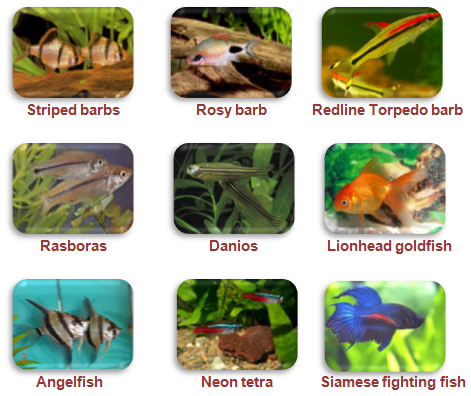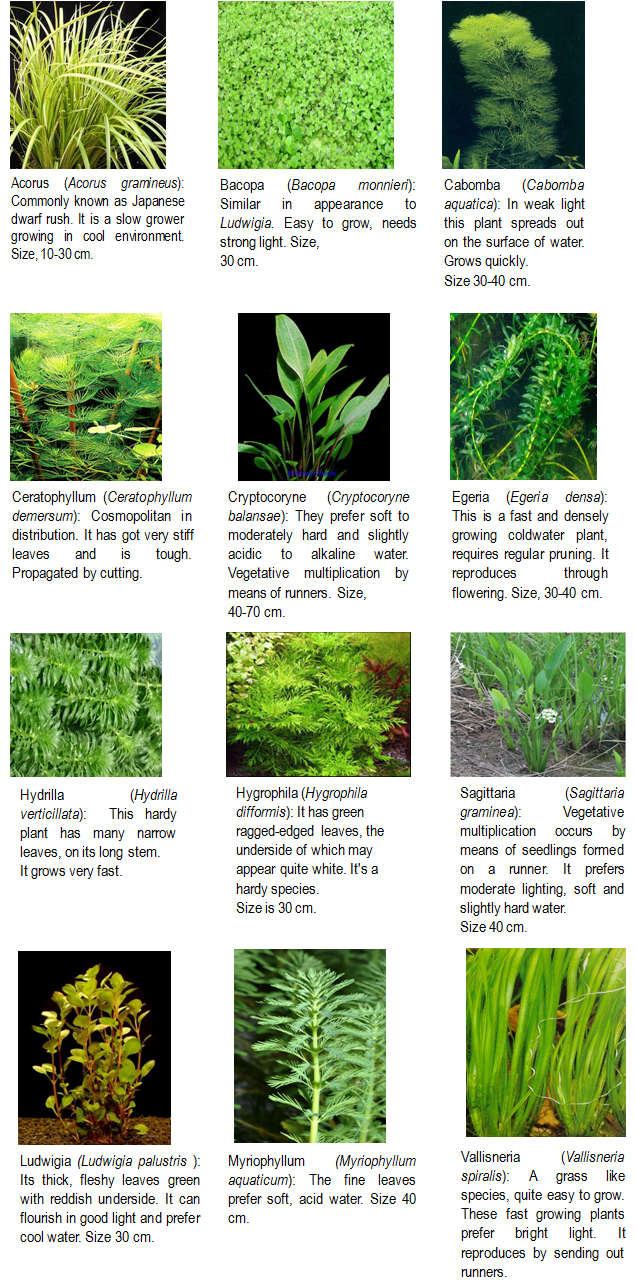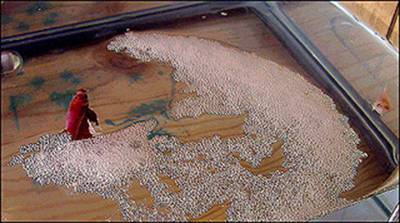
| |||||||||||||||||||||||||||||||||||||||||||||||||||||||||||||||||||||||||||||
| Fisheries :: Ornamental Fisheries | |||||||||||||||||||||||||||||||||||||||||||||||||||||||||||||||||||||||||||||
Aquarium fishes Aquarium fishes are broadly grouped into 2 categories on the basis of their breeding behaviour, viz., egg-layers (oviparous) and livebearers (ovo-viviparous). Egg-layers are further classified as egg-layers with no care (non-guarders), egg-layers with care (guarders), egg buriers, mouth-incubators, nest-builders and egg-carriers on the basis of parental care. Egg layers Important group of egg-layers are barbs, rasboras, goldfish, tetras, danios, betas, angelfish and gouramis. Among them barb is one of the most important groups. Barbs of Indian origin are rosy barb, striped barb and aruli barb. The major group of danios includes gaint danio, pearl danio and zebra danio. Among rasboras slender rasbora, glowlight rasbora and scissortail are the important ones. Goldfishes are the most preferred fish for the aquarium keepers. Some common varieties being comet, lion head, oranda, red cap, veil tail, shubunkin, bubble eye etc. The fish grows up to 20 cm in length, but starts breeding when it is only 6 cm long.
Live bearers They give birth to young ones and reproducing only a few numbers of offspring in comparison to egg layers. Their breeding is relatively easy and development of young ones takes place inside the female, which are released after about 4 weeks. The common livebearers include guppy, black molly, swordtail, and platy. The number of offspring produced by livebearers is between 50-100. If properly fed with natural food, supplemented with better artificial feed, the mortality caused by predation/cannibalism could be checked thereby survival rate of these offspring can be increased.
Aquarium plants
Breeding Egg layers Separate male and female hormones are produced in fishes. During spawning period the female releases eggs in the water and the male simultaneously release milt close to the eggs. The eggs are thus fertilized outside the body of the female (external fertilization). Based on the type of incubation egg laying fishes are further classified into five Egg scatterers laying non-adhesive eggs Zebra fish (Danio spp.) is considered as egg scatterer, which lays non-adhesive eggs. Like many aquarium fishes, zebra fish also eats away its own eggs and spawn after breeding. As the precautionary measure, the bottom of the aquarium should be loaded with a layer of round pebbles of about 6-8 cm diameter. The breeding pair has to be well fed with live food like small zooplanktons. During breeding the male female ration should be maintained at 2:1 or 3:1. The female is introduced in the breeding tank one day earlier than the males. The eggs require 2-3 days hatching time, if the temperature is favourable. As soon as the tiny hatchlings are seen in the aquarium tanks the parents are to be removed. The hatchlings take 2 days to absorb their yellow yolk sac. After 2 days, they are fed with infusorians for 4 days. Subsequently rotifers and smaller zooplanktons can be fed for 1 week, after which they can be provided with powdered formulate feed. Egg scatterers laying adhesive eggs Gold fish (Carassius spp.) is considered as egg scatterer laying adhesive eggs. When secondary sexual characters appear, the male and female gold fishes are selected and kept in circular glass tanks (24’’x 12’’x 15’’) or ferro-cement tank (3.5 ft. x 2.5 ft.) after disinfecting the containers with 1 ppm solution of potassium permanganate. The water used should be a mixture of ground and filtered pond water. The tanks should be placed where some early morning sunshine and no sunlight afterwards fall. Since goldfish eggs are sticky in nature, they require a surface to adhere. For this various artificial nets or submerged aquatic plants such as Hydrilla can be used. The nets should float close to the surface of water. The water temperature should be maintained between 20o and 30o C. The spawner and milter in the ratio of 1:2 are released into the breeding tank in the late evening hours. Egg laying usually takes place within 6-12 hrs. The moment spawning is over nets should be transferred to a different container, or parent fishes are removed from the breeding tank. Generally a female lays about 2000- 3000 eggs. Healthy eggs are golden transparent at the beginning and gradually the transparency decreases. Unfertilized eggs will remain opaque. Under ideal condition, within 3 days, the eggs hatch-out with a hatching rate of 80-90%. When the young larvae start to float the nets and aquarium plants can be removed. Egg depositors Barbs (Rasbora spp.), small fishes that move in groups are ideal for a well-planted community aquarium. A temperature between 25° and 28° C is optimum for their breeding. They are difficult to breed but can lay up to 250 eggs/female. Like barbs they require soft, slightly acidic (pH 5.5) environment. After conditioning male and female are placed in a tank planted with flat leaved plants. Once spawning occurs, as indicated by the sliminess of the female fish, remove both parents from the breeding tank. The eggs laid on the underside of the flat levels will hatch after 24-36 hr and the resultant hatchlings become free swimming after 3-5 days. At this stage the tiny hatchlings should be fed infusorians and newly hatched brine shrimp. As they grow bigger they should be fed zooplanktons, like Moina and Daphnia. Egg buriers Among the egg buriers, the killi fish (Aplocheilus spp.) is the most important. They lay their eggs in a soft peat at the bottom of the tank or in densely planted aquarium tanks. They are good jumpers; therefore, they should be kept in covered aquarium. The eggs are capable of remaining viable even under dried condition and hatching may be possible even after some weeks or months, when placed again in water. In drought condition, parents may die but their eggs remain alive until the next rain. They rarely grow up to 3-4 cm in total length and are short lived. Nest builders The common nest builders are Gourami, Siamese fighter and Angelfish. They are bubble nest builders and incubate their eggs in floating nests, specially made by the male fish.
After 1-2 days, mature male is introduced in the breeding tank. A transparent perforated plastic sheet or a glass is covered over the tank to keep the humidity and temperature at high level, which help to maintain the bubble nest in good condition. The male soon begins to build the bubble nest. This is possible by engulfing a large gulp of air at the water surface and converting it into many smaller bubbles that are passed into gill chamber and coated with an anti-burst agent before release.
The male starts building a bubble nest quite quickly and once this is underway, the partition net is removed. At this crucial stage male should accept the female, otherwise male starts vigorous display of chasing which ultimately leads to fin tearing of female. Fighters often spawn in early morning and within a few hours 200-300 eggs are laid. As the eggs are shed and fertilized, they sink to the bottom. Males then collect them in his mouth and spit them into the bubble nest. At the end of spawning females are removed and male is left to guard the nest for 3 days after which it is removed. The eggs hatch after 36-48 hr. The smaller fry become free swimming after 5 or 6 days during when they can be fed with infusorium and egg-yolk. After 3 or 4 days, frys generally accept fine dry foods. The temperature of the water should be warm at around 27° C.
Bubblenest of siamese fighter fish
The female will deposit a line of eggs on the spawning substrate, followed by the male who will fertilize the eggs. This process will repeat itself until there are a total of 100-600 eggs. The pair will take turns maintaining a high rate of water circulation around the eggs by swimming very close to the eggs and fanning the eggs with their lateral fins. In a few days, the eggs will hatch and the fry will remain attached to the spawning substrate. During this period, the fry will not eat and will survive by consuming the remains of their yolk sacs. At one week, the fry will detach and become free-swimming. Fry can now feed on brine shrimp and after 2 weeks feed on powdered artificial feed. Breeding Livebearers Unlike other fishes, female livebearers are fertilized internally by transferring milt to females by means of the males modified anal fin, the gonopodium. Breeding pattern of guppies and other fishes of this group vary and hence have been dealt separately. Guppy (Poecilia reticulate) Male guppy reaches up to 2.5 – 3.5 cm length, while the female is usually larger when fully grown. They thrive in a large well-planted tank with temperatures within 20o – 25o C. Gravid females with their abdomen enlarged are collected and placed in the breeding tank (30 cm x 20 cm x 20 cm) individually or pairs. Plants like Cabomba can be placed in the aquarium. Once individual females give birth to 20-200 young ones, the tank is aerated. For mass breeding of guppy a tank size (100 cm x 100 cm x 60 cm) is ideal, where a perforated cylindrical basket can be provided in one side of the tank encircled with fibrous plastic flowing filaments where the female can drop the young ones. Soon after birth, the young ones escape from their mother and enter into the perforated basket and latter the young ones are collected from the basket and placed in separate tanks, for further rearing. Platy, Swordtail and Molly The platies, swordtails (Xiphophorus spp.) take 6-8 weeks, while mollies (Poecilia spp.) 12-16 weeks to mature. Like guppies the male used to insert its gonopodium with milts into female, fish and eggs are fertilized inside the mother’s body. After fertilization, the embryo grows to tiny young ones and becomes ready for free swimming within 4 weeks of gestation period. Platies, swordtails and mollies are quite hardy fish; they will breed well in most type of water, so long as it is not too soft or acidic. Addition of little aquarium marine salt or common salt to water (0.5 –1 g/litre) is beneficial for mollies. Breeding table of livebearers
(Source: ICAR, 2006) Disease Management Aquarium fishes develop diseases due to poor environmental condition. Preventing disease is much more economical than providing expensive treatments following disease outbreak. Following steps can be taken to prevent fish diseases.
Common disease of ornamental fishes and their treatments
(Source: ICAR, 2006) Chemicals used in treatment Iodine: Diluted by addition of an equal amount of water to produce a half-strength solution. (Source: Economic Survey, 2007 and ICAR, 2006 and www.vuatkerala.org) | |||||||||||||||||||||||||||||||||||||||||||||||||||||||||||||||||||||||||||||
© TNAU 2008-2024 All Rights Reserved. |
|||||||||||||||||||||||||||||||||||||||||||||||||||||||||||||||||||||||||||||



